Combination of Three Functionalized Temperature-Sensitive Chromatographic Materials for Serum Protein Analysis
Abstract
1. Introduction
2. Results and Discussion
2.1. Preparation and Characterization of Chromatographic Materials
2.2. Temperature Sensitivity of the Materials
2.3. Characterization of Capture Performance
2.4. Combination of Three Functional Temperature-Sensitive Chromatographic Materials for Serum Protein Analysis
3. Materials and Methods
3.1. Materials and Instruments
3.2. Synthesis of CTA-Grafted Silica
3.3. Synthesis and Characterization of the Three Temperature-Responsive Materials
3.4. Chromatographic Assay for the Separation and Enrichment of Steroids and Proteins
3.5. Combination of Three Functional Temperature-Sensitive Chromatographic Materials
4. Conclusions
Supplementary Materials
Author Contributions
Funding
Conflicts of Interest
References
- Aebersold, R.; Mann, M. Mass spectrometry-based proteomics. Nature 2003, 422, 198–207. [Google Scholar] [CrossRef] [PubMed]
- Domon, B.; Aebersold, R. Mass spectrometry and protein analysis. Science 2006, 312, 212–217. [Google Scholar] [CrossRef] [PubMed]
- Deng, Z.; Dong, M.; Wang, Y.; Dong, J.; Li, S.S.; Zhou, H.; Ye, M. Biphasic Affinity Chromatographic Approach for Deep Tyrosine Phosphoproteome Analysis. Anal. Chem. 2017, 89, 2405–2410. [Google Scholar] [CrossRef] [PubMed]
- Alvarez-Lorenzo, C.; Concheiro, A. Smart drug delivery systems: From fundamentals to the clinic. Chem. Commun. 2014, 50, 7743–7765. [Google Scholar] [CrossRef] [PubMed]
- Baeza, A.; Vallet-Regi, M. Smart Mesoporous Silica Nanocarriers for Antitumoral Therapy. Curr. Top. Med. Chem. 2015, 15, 2306–2315. [Google Scholar] [CrossRef] [PubMed]
- Dabbagh, A.; Abdullah, B.J.; Abdullah, H.; Hamdi, M.; Kasim, N.H. Triggering Mechanisms of Thermosensitive Nanoparticles under Hyperthermia Condition. J. Pharm. Sci. 2015, 104, 2414–2428. [Google Scholar] [CrossRef] [PubMed]
- Calejo, M.T.; Sande, S.A.; Nystrom, B. Thermoresponsive polymers as gene and drug delivery vectors: Architecture and mechanism of action. Expert Opin. Drug Del. 2013, 10, 1669–1686. [Google Scholar] [CrossRef] [PubMed]
- Betre, H.; Liu, W.; Zalutsky, M.R.; Chilkotia, A.; Krausc, V.B.; Setton, L.A. A thermally responsive biopolymer for intra-articular drug delivery. J. Control. Release 2006, 115, 175–182. [Google Scholar] [CrossRef] [PubMed]
- Zhang, Q.; Tang, N.; Brock, J.W.; Mottaz, H.M.; Ames, J.M.; Baynes, J.W.; Smith, R.D.; Metz, T.O. Enrichment and analysis of nonenzymatically glycated peptides: Boronate affinity chromatography coupled with electron-transfer dissociation mass spectrometry. J. Proteome Res. 2007, 6, 2323–2330. [Google Scholar] [CrossRef] [PubMed]
- Gil, E.S.; Hudson, S.M. Stimuli-reponsive polymers and their bioconjugates. Prog. Polym. Sci. 2004, 29, 1173–1222. [Google Scholar] [CrossRef]
- Kanazawa, H.; Okano, T. Temperature-responsive chromatography for the separation of biomolecules. J. Chromatogr. A 2011, 1218, 8738–8747. [Google Scholar] [CrossRef] [PubMed]
- Hoffman, A.S.; Stayton, P.S. Conjugates of stimuli-responsive polymers and proteins. Prog. Polym. Sci. 2016, 32, 922–932. [Google Scholar] [CrossRef]
- Kikuchi, A.; Okano, T. Pulsatile drug release control using hydrogels. Adv. Drug Del. Rev. 2002, 54, 53–77. [Google Scholar] [CrossRef]
- Mano, J.F. Stimuli-responsive polymeric systems for biomedical applications. Adv. Eng. Mater. 2008, 10, 515–527. [Google Scholar] [CrossRef]
- Roy, D.; Cambre, J.N.; Sumerlin, B.S. Future perspectives and recent advances in stimuli-responsive materials. Prog. Polym. Sci. 2010, 35, 278–301. [Google Scholar] [CrossRef]
- Stuart, M.A.C.; Huck, W.T.S.; Genzer, J.; Muller, M.; Ober, C.; Stamm, M.; Sukhorukov, G.B.; Szleifer, I.; Tsukruk, V.V.; Urban, M.; et al. Emerging applications of stimuli-responsive polymer materials. Nat. Mater. 2010, 9, 101–113. [Google Scholar] [CrossRef] [PubMed]
- Nakayama, M.; Akimoto, J.; Okano, T. Polymeric micelles with stimulitriggering systems for advanced cancer drug targeting. J. Drug Target 2014, 22, 584–599. [Google Scholar] [CrossRef] [PubMed]
- Nagase, K.; Okano, T. Thermoresponsive-polymer-based materials for temperature-modulated bioanalysis and bioseparations. J. Mater. Chem. B 2016, 4, 6381–6397. [Google Scholar] [CrossRef]
- Heskins, M.; Guillet, J.E. Solution properties of poly(N-isopropylacrylamide). J. Macromol. Sci. A 1968, 2, 1441–1455. [Google Scholar] [CrossRef]
- Schild, H.G. Poly(N-isopropylacrylamide): Experiment, theory and application. Prog. Polym. Sci. 1992, 17, 163–249. [Google Scholar] [CrossRef]
- Dhara, D.; Rathna, G.V.N.; Chatterji, P.R. Volume Phase Transition in Interpenetrating Networks of Poly(N-Isopropylacrylamide) with Gelatin. Langmuir 2000, 16, 2424–2429. [Google Scholar] [CrossRef]
- Gewehr, M.; Nakamura, K.; Ise, N.; Kitano, H. Gel permeation chromatography using porous glass beads modified with temperature-responsive polymers. Macromol. Chem. Phys. 1992, 193, 249–256. [Google Scholar]
- Kanazawa, H.; Yamamoto, K.; Matsushima, Y.; Takai, N.; Kikuchi, A.; Sakurai, Y.; Okano, T. Temperature-ResponsiveChromatography UsingPoly(N-isopropylacrylamide)-Modified Silica. Anal. Chem. 1996, 68, 100–105. [Google Scholar] [CrossRef] [PubMed]
- Lynen, F.; He, M.D.; Prez, F.D.; Brown, R.; Szucs, R.; Sandra, P. Evaluation of the Temperature Responsive Stationary Phase Poly(N-isopropylacrylamide) in Aqueous LC for the Analysis of Small Molecule. Chromatographia 2007, 66, 143–150. [Google Scholar] [CrossRef]
- Ayano, E.; Okada, Y.; Sakamoto, C.; Kanazawa, H.; Kikuchi, A.; Okano, T. Study of temperature-responsibility on the surfaces of a thermo-responsive polymer modified stationary phase. J. Chromatogr. A 2006, 1119, 51–57. [Google Scholar] [CrossRef] [PubMed]
- Mizutani, A.; Nagase, K.; Kikuchi, A.; Kanazawa, H.; Akiyama, Y.; Kobayashi, J.; Annaka, M.; Okano, T. Preparation of thermo-responsive polymer brushes on hydrophilic polymeric beads by surface-initiated atom transfer radical polymerization for a highly resolutive separation of peptides. J. Chromatogr. A 2010, 1217, 5978–5985. [Google Scholar] [CrossRef] [PubMed]
- Nagase, K.; Kobayashi, J.; Kikuchi, A.; Akiyama, Y.; Kanazawa, H.; Annaka, M.; Okano, T. Preparation of Thermoresponsive Anionic Copolymer Brush Surfaces for Separating Basic Biomolecules. Biomacromolecules 2010, 11, 215–223. [Google Scholar] [CrossRef] [PubMed]
- Nagase, K.; Kobayashi, J.; Kikuchi, A.; Akiyama, Y.; Kanazawa, H.; Okano, T. Preparation of thermoresponsive cationic copolymer brush surfaces and application of the surface to separationof biomolecules. Biomacromolecules 2008, 9, 1340–1347. [Google Scholar] [CrossRef] [PubMed]
- Yamanaka, H.; Shinohara, Y.; Hasegawa, Y.; Carredano, E.; Kikuchi, A.; Okano, T. Regulation of Protein Binding toward a Ligand on Chromatographic Matrixes by Masking and Forced-Releasing Effects Using Thermoresponsive Polymer. Anal. Chem. 2002, 74, 4160–4166. [Google Scholar]
- Yamanaka, H.; Yoshizako, K.; Akiyama, Y.; Sota, H.; Hasegawa, Y.; Shimohara, Y. Affinity chromatography with collapsibly tethered ligands. Anal. Chem. 2003, 75, 1658–1663. [Google Scholar] [CrossRef]
- Hosoya, K.; Sawada, E.; Kimata, K.; Araki, T.; Tanaka, N.; Frechet, J.M.J. In Situ Surface-Selective Modification of Uniform Size Macroporous Polymer Particles with Temperature-Responsive Poly-N-isopropylacrylamide. Macromolecules 1994, 27, 3973–3976. [Google Scholar] [CrossRef]
- Lakhiari, H.; Okano, T.; Nurdin, N.; Luthi, C.; Descouts, P.; Muller, D.; Jozefonvicz, J. Temperature- responsive size-exclusion chromatography using poly(N-isopropylacrylamide) grafted silica. Biochim. Biophys. Acta 1998, 1379, 303–313. [Google Scholar] [CrossRef]
- Nagase, K.; Yamato, M.; Kanazawa, H.; Okano, T. Poly( N-isopropylacrylamide)-based thermoresponsive surfaces provide new types of biomedical applications. Biomaterials 2018, 153, 27–48. [Google Scholar] [CrossRef] [PubMed]
- AKimoto, A.M.; Niitsu, E.H.; Nagase, K.; Okano, T.; Kanazawa, H.; Yoshida, R. Mesenchylmal Stem Cell Culture on Poly(N-isopropylacrylamide) Hydrogel with Repeated Thermo-Stimulation. Int. J. Mol. Sci. 2018, 19, 1253. [Google Scholar] [CrossRef] [PubMed]
- Hiruta, Y.; Kanazashi, R.; Ayano, E.; Okano, T.; Kanazawa, H. Temperature-responsive molecular recognition chromatography using phenylalanine and tryptophan derived polymer modified silica beads. Analyst 2016, 141, 910–917. [Google Scholar] [CrossRef] [PubMed]
- Liu, Z.; Su, R.; Liang, X.; Deng, Y.; Li, Y.; Dai, R. A thermally switchable chromatographic material for selective capture and rapid release of proteins and nucleotides. RSC Adv. 2014, 4, 15830–15834. [Google Scholar] [CrossRef]
- Wang, J.S.; Matyjaszewski, K. Controlled/”living” radical polymerization. atom transfer radical polymerization in the presence of transition-metal complexes. J. Am. Chem. Soc. 1995, 117, 5614–5615. [Google Scholar] [CrossRef]
- Wang, J.S.; Matyjaszewski, K. Controlled/”living” radical polymerization. halogen atom transfer radical polymerization promoted by a Cu(I)/Cu(II) redox process. Macromolecules 1995, 28, 7901–7910. [Google Scholar] [CrossRef]
- Unsal, E.; Elmas, B.; Çaglayan, B.; Tuncel, M.; Patir, S.; Tuncel, A. Preparation of An Ion Exchange Chromatographic Support By A New “Grafting From” Strategy Based on Atom Transfer Radical Polymerization. Anal. Chem. 2006, 78, 5868–5875. [Google Scholar] [CrossRef] [PubMed]
- Nagase, K.; Kobayashi, J.; Kikuchi, A.; Akiyama, Y.; Kanazawa, H.; Okano, T. Monolithic silica rods grafted with thermoresponsive anionic polymer brushes for high-speed separation of basic biomolecules and peptides. Biomacromolecules 2014, 15, 1204–1215. [Google Scholar] [CrossRef] [PubMed]
- Shakya, A.K.; Holmdahl, R.; Nandakumar, K.S.; Kumar, A. Characterization of chemically defined poly-N-isopropylacrylamide based copolymeric adjuvants. Vaccine 2013, 31, 3519–3527. [Google Scholar] [CrossRef] [PubMed]
- Liu, Z.; Ullah, K.; Su, L.; Lv, F.; Deng, Y.; Dai, R.; Li, Y.; Zhang, Y. Switchable boronate affinity materials for thermally modulated capture, separation and enrichment of cis-diol biomolecules. J. Mater. Chem. 2012, 22, 18753–18756. [Google Scholar] [CrossRef]
- Springsteen, G.; Wang, B. A detailed examination of boronic acid–diol complexation. Tetrahedron 2002, 58, 5291–5300. [Google Scholar] [CrossRef]
- Rzaev, Z.M.O.; Dincer, S.; Piskin, E. Functional copolymers of N-isopropylacrylamide for bioengineering applications. Prog. Polym. Sci. 2007, 32, 534–595. [Google Scholar] [CrossRef]
- Hong, J.; Wang, Q.; Lin, Y.; Fan, Z. Styrene polymerization in the presence of cyclic trithiocarbonate. Macromolecules 2005, 38, 2691–2695. [Google Scholar] [CrossRef]
- Roohi, F.; Titirici, M.M. Thin thermo-responsive polymer films onto the pore system of chromatographic beads via reversible addition–fragmentation chain transfer polymerization. New, J. Chem. 2008, 32, 1409–1414. [Google Scholar] [CrossRef]
- Titirici, M.M.; Sellergren, B. Thin molecularly imprinted polymer films via reversible addition-fragmentation chain transfer polymerization. Chem. Mater. 2006, 18, 1773–1779. [Google Scholar] [CrossRef]
- Cammas, S.; Suzuki, K.; Sone, C.; Sakurai, Y.; Kataoka, K.; Okano, T. Thermoresponsive polymer nanoparticles with a core-shell micelle structure as sitespecific drug carriers. J. Control. Release 1997, 48, 157–164. [Google Scholar] [CrossRef]
- Chung, J.E.; Yokoyama, M.; Yamato, M.; Aoyagi, T.; Sakurai, Y.; Okano, T. Thermo-responsive drug delivery from polymeric micelles constructed using block copolymers of poly(N-isopropylacrylamide) and poly(butylmethacrylate). J. Control. Release 1999, 62, 115–127. [Google Scholar] [CrossRef]
- Kurisawa, M.; Yokoyama, M.; Okano, T. Gene expression control by temperature with thermo-responsive polymeric gene carriers. J. Control. Release 2000, 69, 127–137. [Google Scholar] [CrossRef]
- Takeda, N.; Nakamura, E.; Yokoyama, M.; Okano, T. Temperature-responsive polymeric carriers incorporating hydrophobic monomers for effective transfection in small doses. J. Control. Release 2004, 95, 343–355. [Google Scholar] [CrossRef] [PubMed]
- Akimoto, J.; Nakayama, M.; Okano, T. Temperature-responsive polymeric micelles for optimizing drug targeting to solid tumors. J. Control. Release 2014, 193, 2–8. [Google Scholar] [CrossRef] [PubMed]
- Man, Y.; Peng, G.; Lv, X.; Liang, Y.; Wang, Y.; Chen, Y.; Deng, Y. Microchip-Grafted P(NIPAAm-co-VPBA) with Thermoresponsive Boronate Affinity for Capture–Release of cis-Diol Biomolecules. Chromatographia 2015, 78, 157–162. [Google Scholar] [CrossRef]
- Shen, Y.; Dong, L.; Liang, Y.; Liu, Z.; Dai, R.; Meng, W.; Deng, Y. Effect of the grafting ratio of poly(N-isopropylacrylamide) on thermally responsive polymer brush surfaces. J. Sep. Sci. 2017, 40, 524–531. [Google Scholar] [CrossRef] [PubMed]
- Lai, J.T.; Filla, D.; Shea, R. Functional Polymers from Novel Carboxyl-Terminated Trithiocarbonates as Highly Efficient RAFT Agents. Macromolecules 2002, 35, 6754–6756. [Google Scholar] [CrossRef]
- Liu, Z.; Geng, F.; Ha, X.; Feng, Y.; Che, B.; Wu, K.; Li, Y.; Dai, R.; Zhang, Y.; Deng, Y. Evaluation of Temperature-Responsive Open Tubular Capillary Electrochromatographic Column Modified with Poly(N-isopropylacrylamide). Chromatographia 2013, 76, 201–206. [Google Scholar] [CrossRef]
- Dai, R.; Lei, C.; Liu, Z.; Wang, H.; Hu, D.; Deng, Y. Preparation and characterization of temperature-responsive chromatographic column containing poly(N-isopropylacrylamide) and poly([2-(methacryloyloxy)- ethyl]trimetylammonium chloride). J. Appl. Polym. Sci. 2011, 121, 2233–2238. [Google Scholar] [CrossRef]
- Liu, M.S.; Taylor, C.; Chong, B.; Liu, L.; Bilic, A.; Terefe, N.S.; Stockmann, R.; Thang, S.H.; Silva, K.D. Conformational transitions and dynamics of thermal responsive poly(N-isopropylacrylamide) polymers as revealed by molecular simulation. Eur. Polym. J. 2014, 55, 153–159. [Google Scholar] [CrossRef]
- Liang, Y.; Geng, F.; Dai, R.; Deng, Y. Enrichment of adenosine using thermally responsive chromatographic materials under friendly pH conditions. J. Sep. Sci. 2015, 38, 4036–4042. [Google Scholar] [CrossRef]
- Unger, K.K.; Ditz, R.; Machtejevas, E.; Skudas, R. Liquid Chromatography—Its Development and Key Role in Life Science Applications. Angew. Chem. Int. Ed. 2010, 49, 2300–2312. [Google Scholar] [CrossRef]
- Nagase, K.; Akimoto, A.M.; Kobayashi, J.; Kikuchi, A.; Akiyama, Y.; Kanazawa, H.; Okano, T. Effect of reaction solvent on the preparation of thermoresponsive stationary phase through a surface initiatedatom transfer radical polymerization. J. Chromatogr. A 2011, 1218, 8617–8628. [Google Scholar] [CrossRef] [PubMed]
- Seino, M.; Yokomachi, K.; Hayakawa, T.; Kikuchi, R.; Kakimoto, M.A.; Horiuchi, S. Preparation of poly(N-isopropylacrylamide) grafted silica bead using hyperbranched polysiloxysilane as polymer brush and application to temperature-responsive HPLC. Polymer 2006, 47, 1946–1952. [Google Scholar] [CrossRef]
Sample Availability: Not available. |
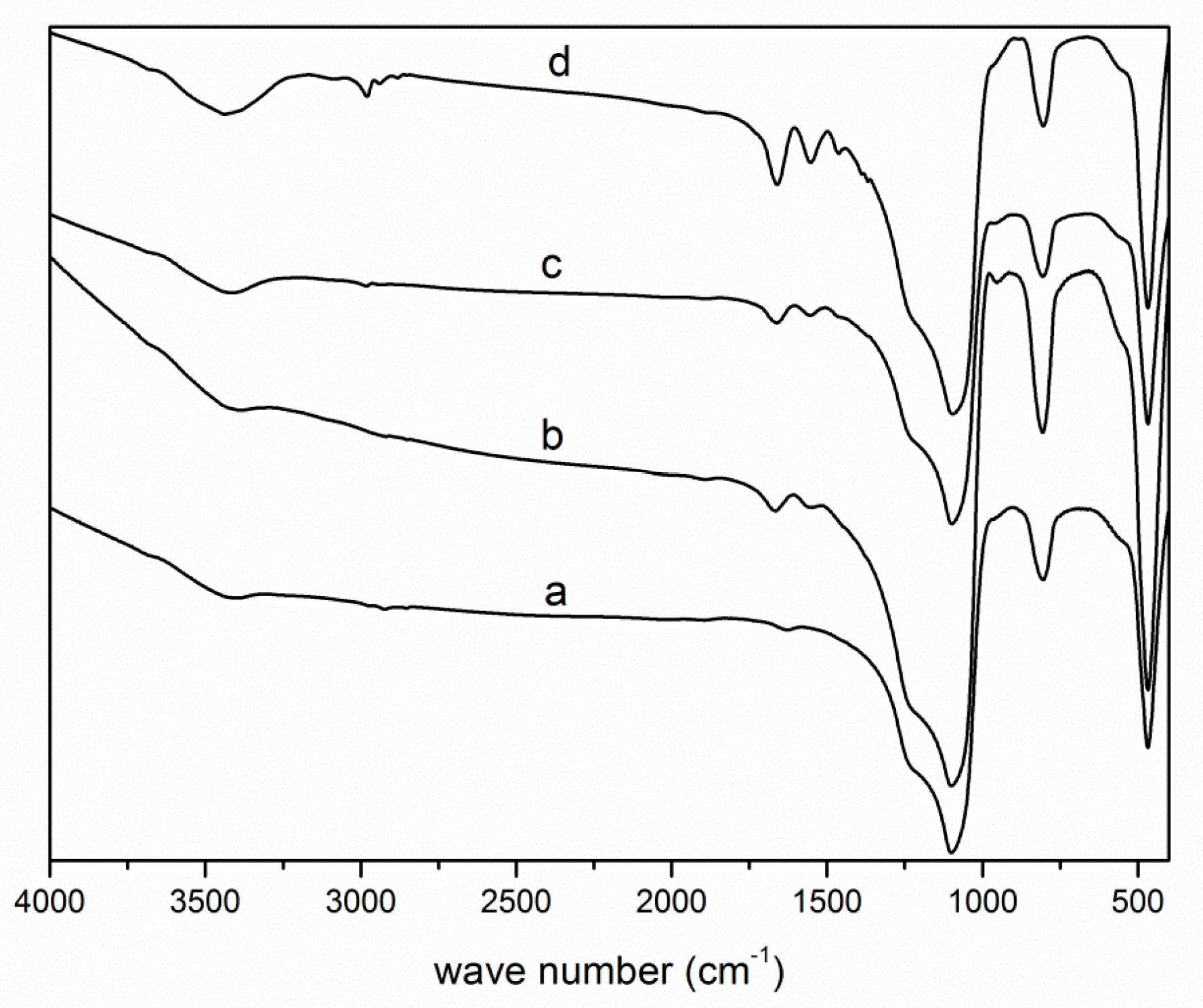

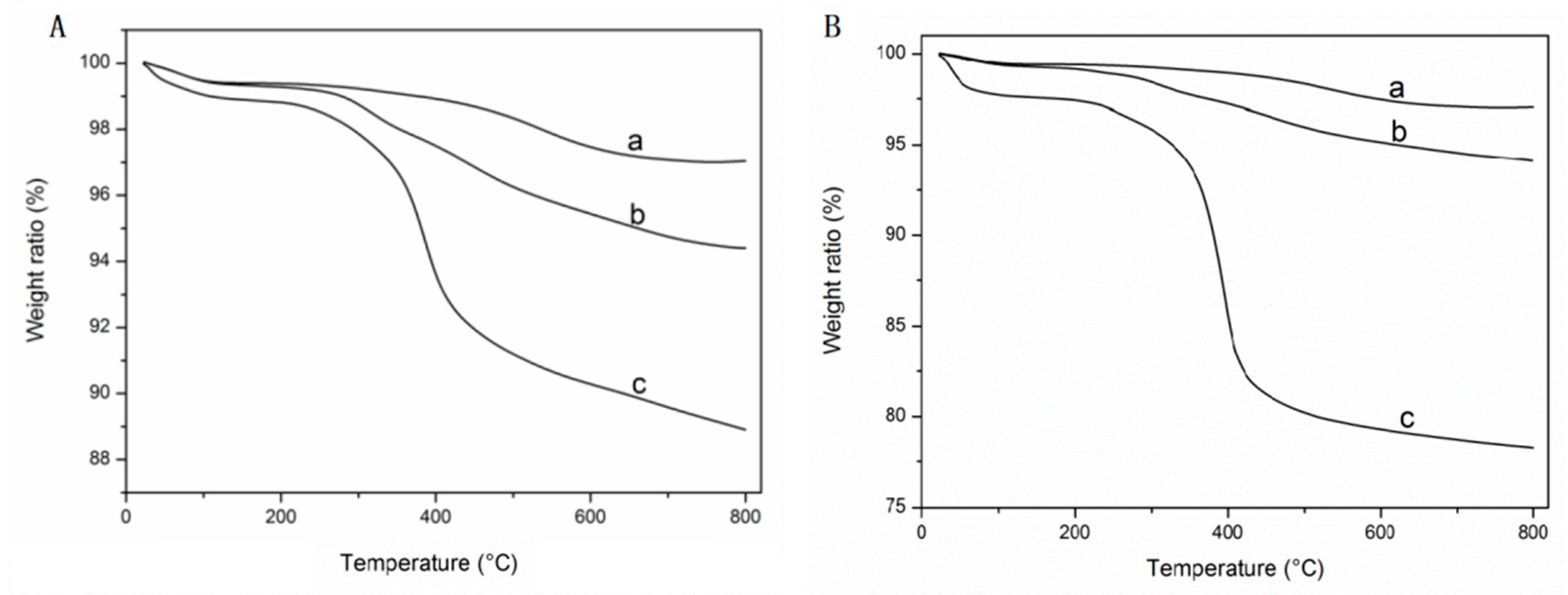
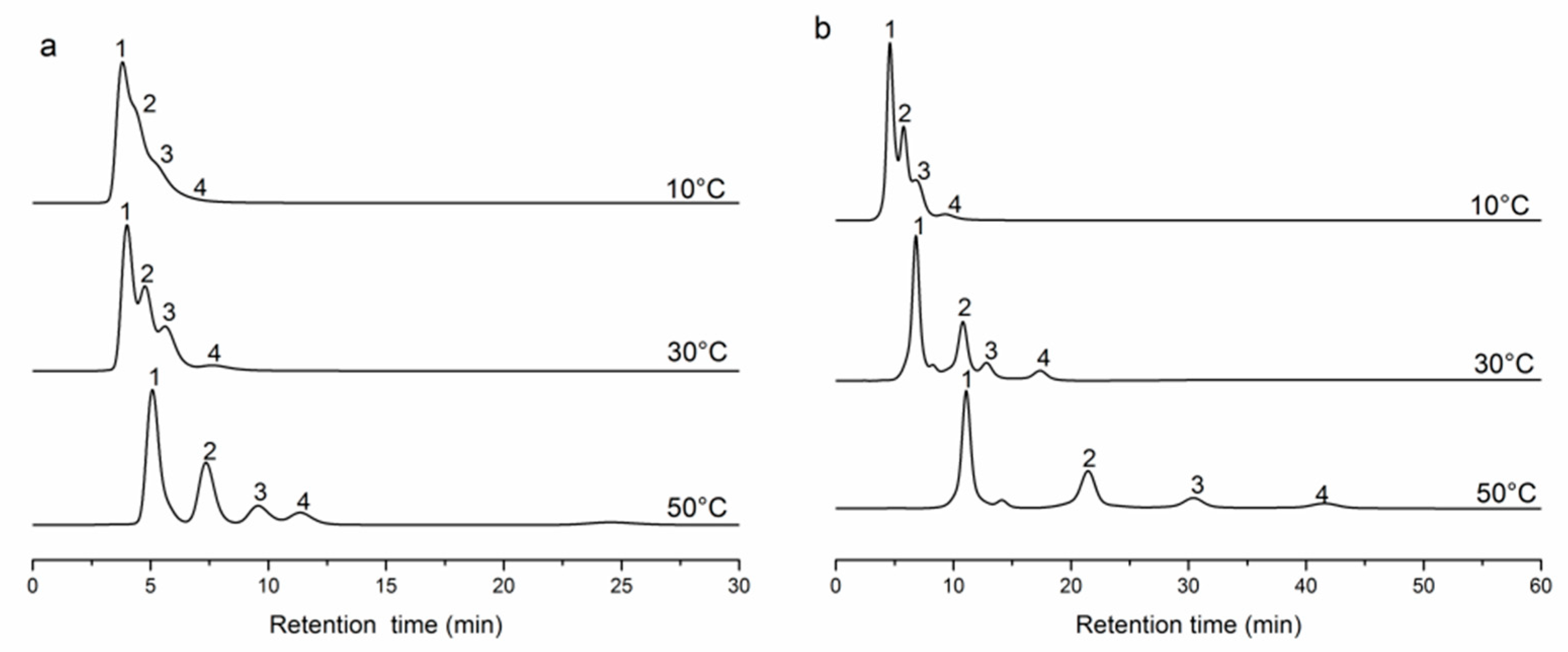
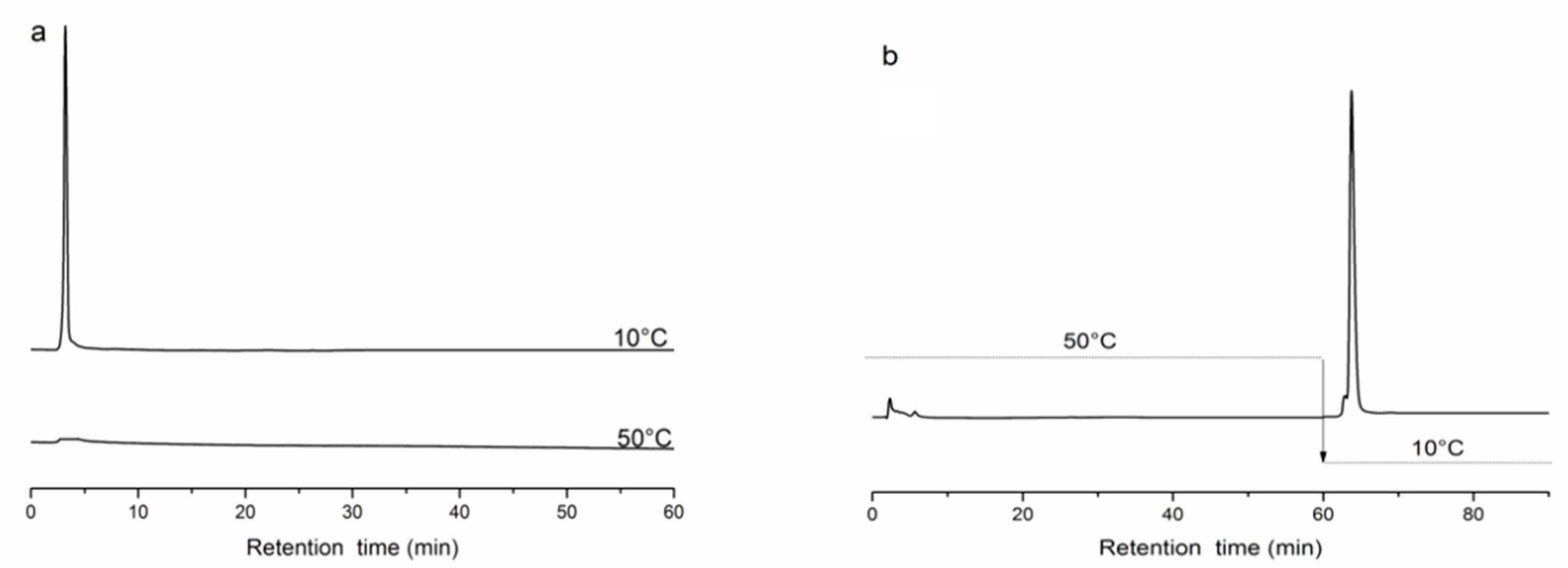
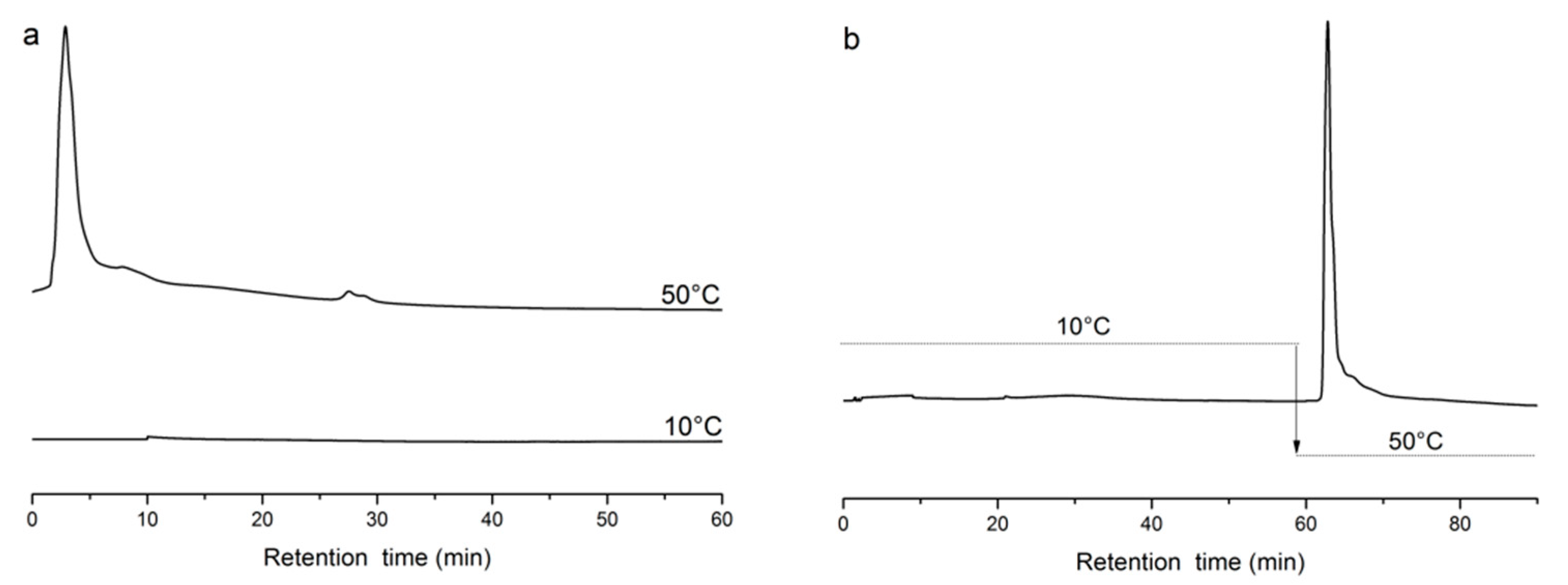
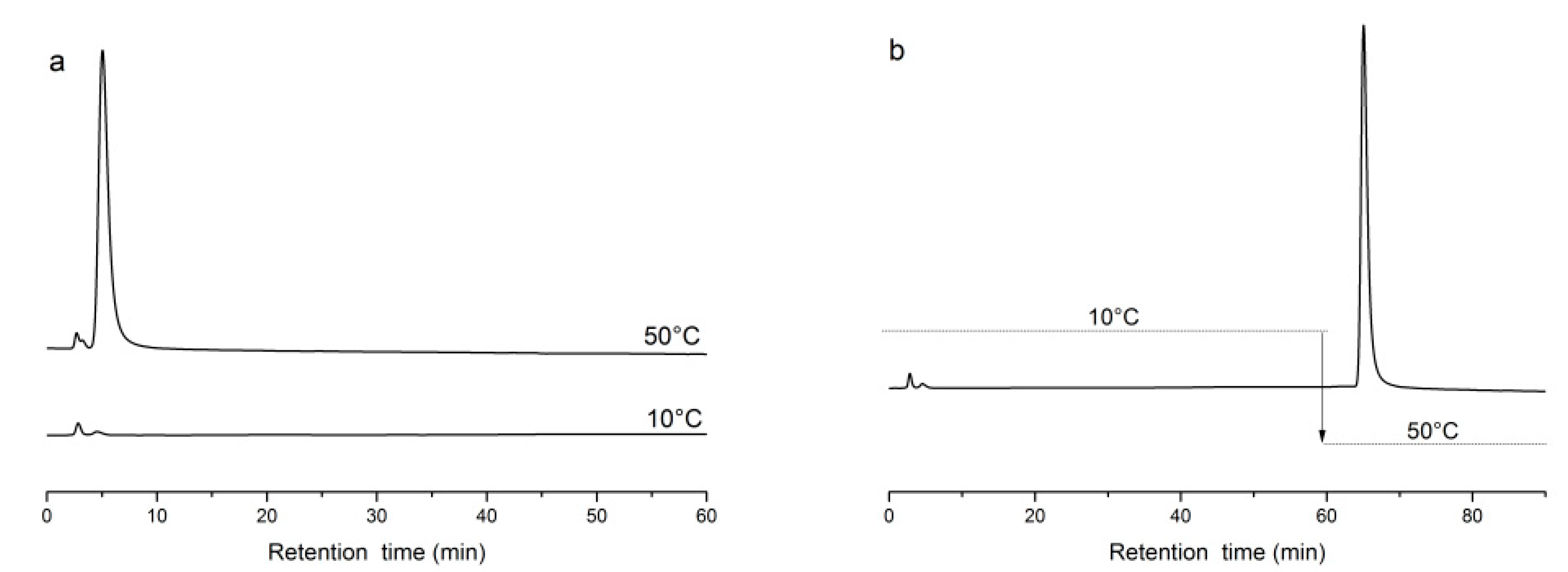


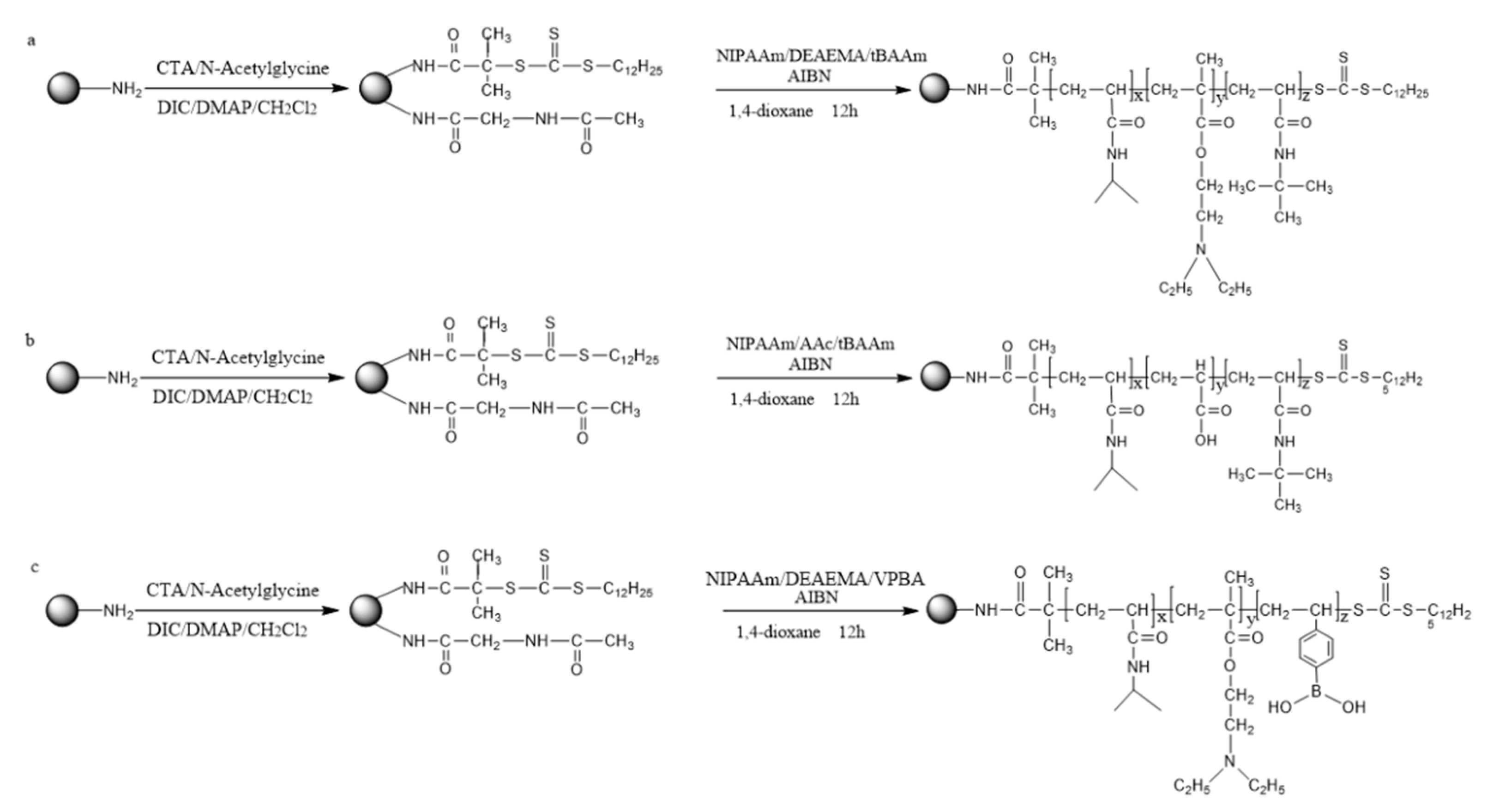
| Element | C1s (%) | O1s (%) | N1s (%) | S2p (%) |
|---|---|---|---|---|
| NH2-grafted silica | 39.61 | 58.94 | 1.45 | 0 |
| CTA-grafted silica 30% | 49.47 | 47.16 | 1.67 | 1.71 |
| CTA-grafted silica 50% | 46.50 | 49.68 | 2.37 | 1.44 |
| poly(NIPAAm-co-DEAEMA-co-tBAAm)-grafted silica 30% | 53.65 | 41.95 | 3.21 | 1.19 |
| poly(NIPAAm-co-DEAEMA-co-tBAAm)-grafted silica 50% | 75.18 | 21.97 | 2.04 | 0.81 |
© 2019 by the authors. Licensee MDPI, Basel, Switzerland. This article is an open access article distributed under the terms and conditions of the Creative Commons Attribution (CC BY) license (http://creativecommons.org/licenses/by/4.0/).
Share and Cite
Sun, W.; Dai, R.; Li, B.; Dai, G.; Wang, D.; Yang, D.; Chu, P.; Deng, Y.; Luo, A. Combination of Three Functionalized Temperature-Sensitive Chromatographic Materials for Serum Protein Analysis. Molecules 2019, 24, 2626. https://doi.org/10.3390/molecules24142626
Sun W, Dai R, Li B, Dai G, Wang D, Yang D, Chu P, Deng Y, Luo A. Combination of Three Functionalized Temperature-Sensitive Chromatographic Materials for Serum Protein Analysis. Molecules. 2019; 24(14):2626. https://doi.org/10.3390/molecules24142626
Chicago/Turabian StyleSun, Weiwei, Rongji Dai, Bo Li, Guoxin Dai, Di Wang, Dandan Yang, Pingping Chu, Yulin Deng, and Aiqin Luo. 2019. "Combination of Three Functionalized Temperature-Sensitive Chromatographic Materials for Serum Protein Analysis" Molecules 24, no. 14: 2626. https://doi.org/10.3390/molecules24142626
APA StyleSun, W., Dai, R., Li, B., Dai, G., Wang, D., Yang, D., Chu, P., Deng, Y., & Luo, A. (2019). Combination of Three Functionalized Temperature-Sensitive Chromatographic Materials for Serum Protein Analysis. Molecules, 24(14), 2626. https://doi.org/10.3390/molecules24142626





